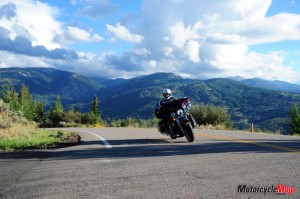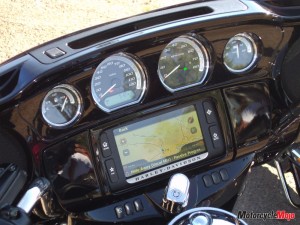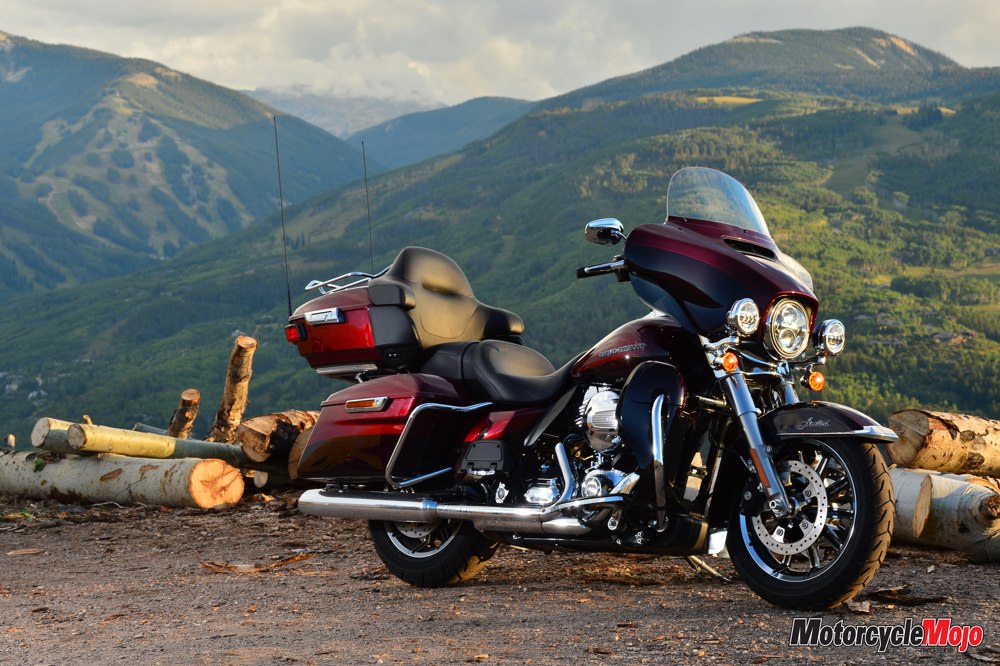Harley-Davidson has released a plethora of upgrades from Project Rushmore – the most noteworthy is the introduction of liquid cooling to the Motor Company’s big V-twin
Harley’s modern, overhead-valve, 45-degree, pushrod V-twin traces its roots to the 1936 Knucklehead, and since then, the rush of passing air has cooled it. But the engine got bigger over the years, and increasingly stringent emissions regulations have made it harder to maintain competitive performance. So, for 2014, it gets some help with the addition of liquid cooling. As a fan of Harley-Davidson motorcycles (I’ve owned four and raced three, including a Buell), I was looking forward to my first ride on a Harley with a liquid-cooled big twin, and my chance came at Harley’s 2014 touring model press launch, held in Golden, Colorado.
The new engine was only part of a complete makeover of eight new Harley models for 2014, introduced under the name Project Rushmore. Other changes under Project Rushmore include a more powerful, air-cooled Twin Cam 103 engine, improved aerodynamics and revised bodywork on the touring bikes, redesigned handlebar switches, new headlights (twin halogens or LED, depending on the model), a hydraulic clutch, ABS brakes that are now linked, and a new infotainment system, the first time the automotive term has been used on a motorcycle.
The new Twin-Cooled High Output Twin Cam 103 engine, as it’s officially called, has been released on the Ultra Limited, Tri Glide Ultra and the CVO Limited. The engine’s new liquid-cooled cylinder heads are not revolutionary, but they use technology similar to the 2013 BMW R1200GS. It was the sensible next step Harley-Davidson had to take to reduce emissions on their 45-degree V-twin. It was a difficult task, however, since Harley loyalists want the traditional look of air cooling, and will shun the additional clutter of liquid cooling.
 Liquid cooling requires a radiator, a water pump and coolant hoses, all of which are hard to hide on a motorcycle, especially one whose engine isn’t obscured by a fairing. My 2014 Ultra Limited test bike is equipped with the Twin-Cooled engine, and Harley engineers did a stellar job of concealing its cooling system. You cannot tell it is liquid cooled when looking at it from the side; only upon very close inspection will you see two rubber hoses leading forward, above the front cylinder head, beneath the fuel tank.
Liquid cooling requires a radiator, a water pump and coolant hoses, all of which are hard to hide on a motorcycle, especially one whose engine isn’t obscured by a fairing. My 2014 Ultra Limited test bike is equipped with the Twin-Cooled engine, and Harley engineers did a stellar job of concealing its cooling system. You cannot tell it is liquid cooled when looking at it from the side; only upon very close inspection will you see two rubber hoses leading forward, above the front cylinder head, beneath the fuel tank.
From the front, the cooling system is more easily revealed, as twin radiators are nestled inside the left and right fairing lowers. Less conspicuous is the electric water pump, located in front of and below the engine, behind a cover; on Harley’s air-cooled tourers, it’s where the oil cooler is located.
Aside from the twin radiators, another distinguishing feature on the new bike is a redesigned batwing fairing. It closely resembles the previous fairing, except that it protrudes just a bit farther forward of the headlight, and it now has an air intake just below the windshield. The opening forces a stream of air up the backside of the windshield, and it is very effective at reducing helmet buffeting, which was somewhat of an annoyance on the outgoing touring models. The factory claims helmet buffeting is reduced by 20 percent, but when opening and closing the vent at highway speeds, it felt like the reduction was more than that. It also reduced noise levels.
The temperatures in Golden hovered around the low 30s Celsius, but heat coming off the radiators is ducted away from the rider, exiting through ports on the outside of the fairing lowers. We found that the bike felt no warmer than an air-cooled one that we had on hand for comparison.
Horsepower and torque are said to have increased by 5 to 7 percent in both the new “High Output” air-cooled and liquid-cooled engines. The High Output 103 engines produce 105 ft-lb of torque, up from 100 ft-lb on the outgoing engine. Unfortunately, the high elevation of the launch location stifled the power somewhat, so it’s not possible to make a fair comparison with the current Twin Cam 103, but in lower gears, acceleration felt more than adequate. The liquid-cooled bike sounds and feels no different than the air-cooled one, which will mean a great deal to traditionalists.
According to Harley, although the liquid-cooled engine doesn’t produce more power than the new air-cooled one, its power output is more stable, and it will maintain its power more consistently than the air-cooled mill. As the air-cooled engine heats up, ignition is retarded to prevent engine knock, which reduces power. This doesn’t happen on the Twin-Cooled engine.
 When you are seated, the view from the saddle is familiar, but there are now just four larger gauges on the dash instead of six. This has cleaned up the dash, which on the Limited also includes a 6.5-inch touchscreen. The Limited’s Harmon-Kardon BOOM! Box 6.5GT infotainment system has 75 watts per channel, GPS navigation, Bluetooth connectivity, satellite radio (subscription separate), a USB port and other features.
When you are seated, the view from the saddle is familiar, but there are now just four larger gauges on the dash instead of six. This has cleaned up the dash, which on the Limited also includes a 6.5-inch touchscreen. The Limited’s Harmon-Kardon BOOM! Box 6.5GT infotainment system has 75 watts per channel, GPS navigation, Bluetooth connectivity, satellite radio (subscription separate), a USB port and other features.
This is a top-of-the-line sound system that easily matches a modern automotive system in sound quality and user interface. In fact, the interface has been simplified for use on a motorcycle, and is rather comprehensive. It took me about one minute to figure out how to pair my iPhone to the system.
It is, however, distracting to use. You still have to look at the screen to make menu selections, and even though Harley’s engineers did extensive research to minimize the time you take your eyes off the road, it’s no less distracting than it is in a car, and us biker types are constantly bitching (rightfully) about distracted drivers. Admittedly, I wasn’t yet familiar with the system, so I’d suggest that if you buy a Harley with the infotainment system, you should go through all of its functions and get familiar with them before hitting the road.
One major gripe I have with the system, aside from its propensity to distract, is that it cannot be wirelessly paired with other communication systems. I brought my Schuberth C3 helmet with the SRC communication system by Cardo installed, and I couldn’t use it. Designers of the sound system did this deliberately because they didn’t like the functionality of aftermarket systems. A microphone and helmet-speaker unit is available with Harley’s system, but it’s hard-wired to the bike, and if you use it, you can’t use an intercom system to communicate with other riders. The only way to have two-way communication with other riders is to use the bike’s CB radio – quite an oversight on a touring bike with a modern infotainment system.
The standard sound system is a BOOM! Box 4.5 system that uses a 4.5-inch screen flanked by buttons on either side for making menu selections. There’s no satellite radio or GPS, but it has full connectivity. There is one five-way mini-joystick located on each handlebar switch assembly, used to scroll through the different menus, and you can also select items directly from the touchscreen with gloved hands.
Another improvement to the new touring bikes is the front suspension. Fork tubes are now 49 mm, up from 41, and damping and spring rates have been altered for a more compliant ride. The fork has, in fact, lost the harshness of the previous model, and suspension compliance front and rear is very well managed.
One very welcome change is to the saddlebag and tour-pack latches. To put it simply, they’ve gone from being among the worst in the business to the best. Saddlebags now have a lever on the inboard side of the covers and can be opened or closed with one hand, even while seated on the bike. Latching them when the bags are closed pulls the covers down tight enough that even without a rubber water seal in place, I think water won’t get in. The tour pack is also a snap to open and close.
The hydraulic clutch is relatively light, and gear changes on the six-speed gearbox feel firm. Since I rode the bike in Colorado, Harley launched a voluntary recall on touring bikes with hydraulic clutches to fix a problem with possible improper disengagement. It’s apparently an easy fix that takes less than an hour to perform.
Sixth gear is a tall, fuel-saving ratio, though the engine is capable of pulling top gear smoothly at 100 km/h, something that causes other V-twins to quake. Quick passing required a couple of downshifts, at least at these high elevations.
ABS brakes are now linked, with the brake lever providing some rear braking and the pedal actuating one piston in one front caliper. To ease low-speed manoeuvrability, the brakes are only linked at speeds above 40 km/h; below that speed, the brakes work independently.
Among the changes to other bikes, the Twin Cam 96 engine has been dropped, and the Twin Cam 103 engine is now on all big-twin models for 2014. Also, all Sportster models have available ABS.
The changes introduced with Project Rushmore stem from requests made by Harley owners, most of whom had demanded that the spirit of the machines remain intact regardless of the improvements made. Harleys sell on tradition – even to newer buyers – and the company had to make improvements without wavering too far from that tradition. And in that respect, Harley got it right.
| The Basics | |
| LIST PRICE | $29,529 |
| WARRANTY | 2 years, unlimited mileage |
| COMPANY URL | www.harleycanada.com |
| ENGINE TYPE | 45-degree, pushrod V-twin |
| DISPLACEMENT | 1690 cc |
| the drivetrain | |
| POWER | N/A |
| TORQUE | 105.5 ft-lb (143 N-m) at 3750 rpm |
| BORE AND STROKE | 98.4 x 111.1 mm |
| COMPRESSION RATIO | 10.0:1 |
| FUEL DELIVERY | Sequential fuel injection |
| TRANSMISSION | 6-speed |
| FINAL DRIVE TYPE | Belt |
| The essentials | |
| FRONT SUSPENSION | 49 mm telescopic fork, non-adjustable |
| REAR SUSPENSION | Twin, air-adjustable shocks |
| WHEEL TRAVEL | Front: 117 mm (4.6 in.); Rear: 76 mm (3 in.) |
| BRAKES | Front: twin 300 mm discs with 4-piston calipers; Rear: 300 mm disc with 4-piston caliper; linked ABS |
| WHEELBASE | 1625 mm (64 in.) |
| RAKE AND TRAIL | 29 degrees/170 mm |
| TIRES | Front: 130/80B-17; Rear: 180/65B-16 |
| WEIGHT (WET) | 406 kg (896 lb.) |
| SEAT HEIGHT | 740 mm (29.1 in.) |
| FUEL CAPACITY | 22.7 litres |
| FUEL ECONOMY (CLAIMED) | 5.6 L/100 km |
| FUEL RANGE (ESTIMATED) | 405 km |




































